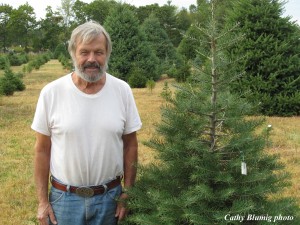Like farmers everywhere, Wolgast Tree Farm & Apiary has dealt with conflicts concerning white-tailed deer. We’ve never had an issue with deer eating (browsing) our Christmas trees, but buck rubs are another matter. A buck rub is created when a male deer uses his forehead and antlers to rub up and down the trunk of a tree which scrapes off the tree’s bark and branches and sometimes even breaks the tree in half.

This buck white-tailed deer was caught in the act of rubbing a Canaan fir tree on our farm with a motion and heat-detecting game camera. A single buck can rub many trees and cause significant tree damage in the process.
Bucks do this as part of the white-tailed deer breeding season (also called the rut) to communicate with other deer. Other deer not only see the damage to the tree but they smell it. Bucks have glands at the base of their antlers and near their eyes which produce their own unique scent. This scent is left on the tree so that other deer know who’s handiwork it is.
Just what is a buck that rubs a tree trying to say? Well, to the other male deer he is saying something like, “See what I did to this tree? You better not mess with me or you’ll get the same thing. Leave all the girl deer for me!” And to the does he is saying something like, “Look what I did to this tree. Aren’t I big and strong? I’d be a great father to your fawns!”
The rut for white-tailed deer generally reaches its peak on November 10th here in New Jersey, but bucks rubs are among a variety of rut activities that start long before that. In the space of about 20 seconds a single buck can rub out years of work that we’ve put into producing an individual Christmas tree. One year we counted over 70 buck-rubbed Christmas trees. That’s a lot of damage, especially for a small family-owned farm like ours so we use a variety of preventative measures to keep damage to a minimum.

To help keep bucks from rubbing our Christmas trees we spray each individual tree with a deer repellant. It’s very labor intensive, but seems to work pretty well – until it rains and gets washed off. Then we have to start all over again.
One of the things we do is use backpack sprayers to spray deer repellant on our trees in September just before bucks typically start to rub. The label on the repellent package says the formula is only supposed to keep deer from browsing the trees (which deer around our farm don’t seem to do), but we’ve found that it seems to keep bucks from rubbing trees as well. Spraying each tree is a big effort, but we think its worth it so long as it works. Problem is, when it rains the repellant gets washed off and we have to spray the trees all over again. During some seasons we’ve had to re-spray our trees five times. That can get pretty old.
This past summer we read about a new kind of repellant that is supposedly longer lasting (up to 6 months). They are called “Whiff Bars” and they were developed by an orchardist to prevent deer browse damage to fruit trees. They look like those small bars of soap that hotels put out for guests. When we opened the box that they were shipped in the aroma smelled like your great aunt’s perfume. I know if I were a deer I wouldn’t feel like nibbling on trees that had them, but here again, our problem is rubbing, not nibbling, so whether they’ll be effective for what we want we’ll have to see. We think its at least worth a try.
Earlier this month Len went out and attached the bars to our most vulnerable trees (Canaan, Concolor and Nordmann firs, White Pines and Norway Spruce).

Earlier this month Len tied deer repellant “Whiff Bars” to our farm’s trees that are most vulnerable to buck rubs. The Whiff Bars are supposed to keep deer from browsing the trees, but we hope they keep bucks from rubbing them as well.
They look like little Christmas ornaments and we’re sure they’ll be a conversation item when folks come out to the farm and wander the fields in search of their family tree come Christmas time. Like the deer repellant we spray, we don’t smell anything when we walk near the trees with the bars, but deer have a sense of smell that is much more sensitive than ours so its probably very apparent to them. At least we hope that’s the case!
We like having deer around here at Wolgast Tree Farm & Apiary, but we aren’t so thrilled with buck rubs on our Christmas trees. We hope that between spraying deer repellant and outfitting our Christmas trees with Whiff Bars that we’ll be able to make sure that the bucks will stop (rubbing) here.